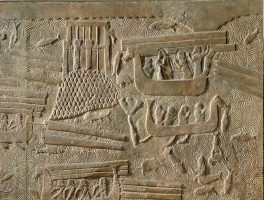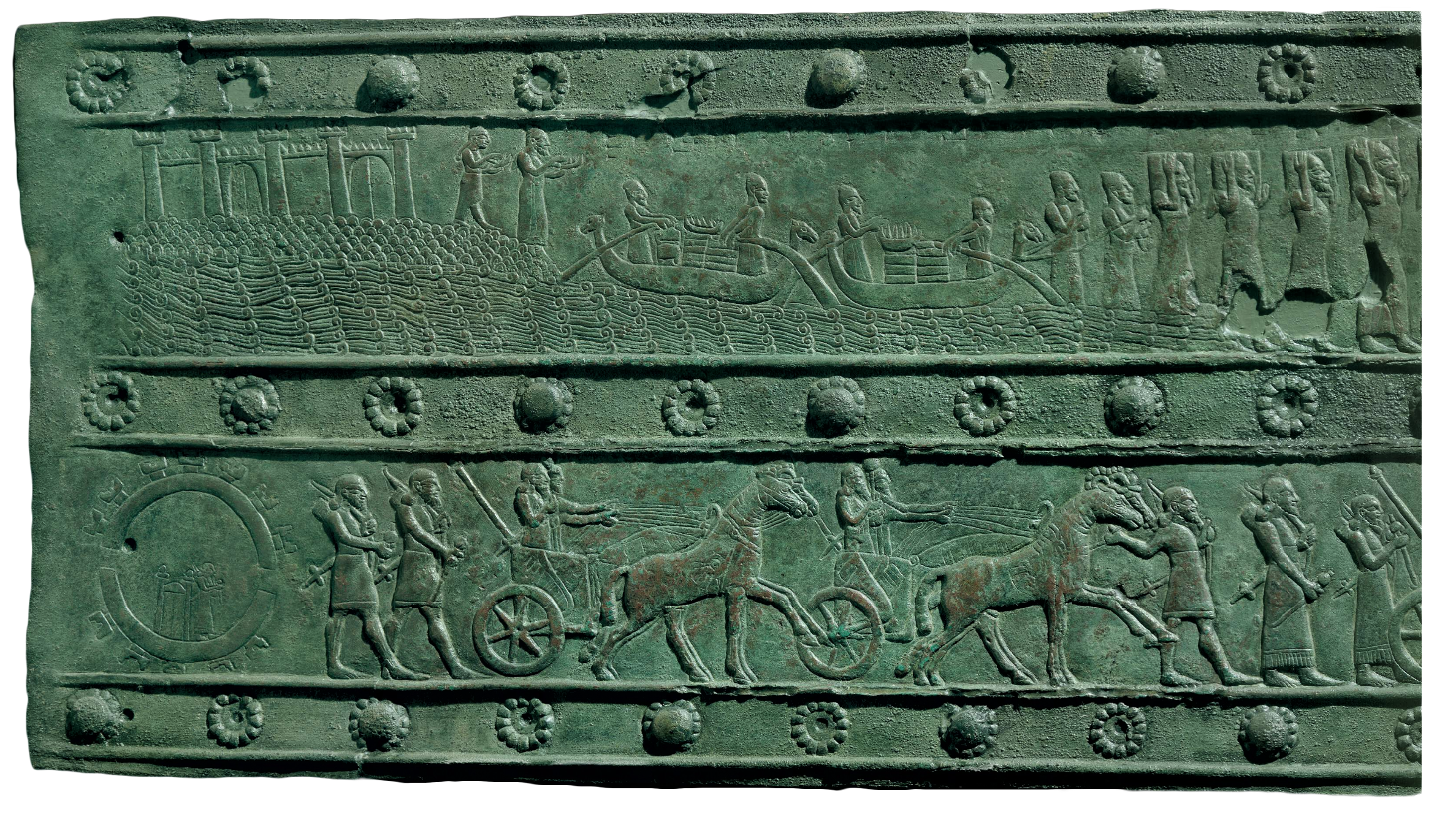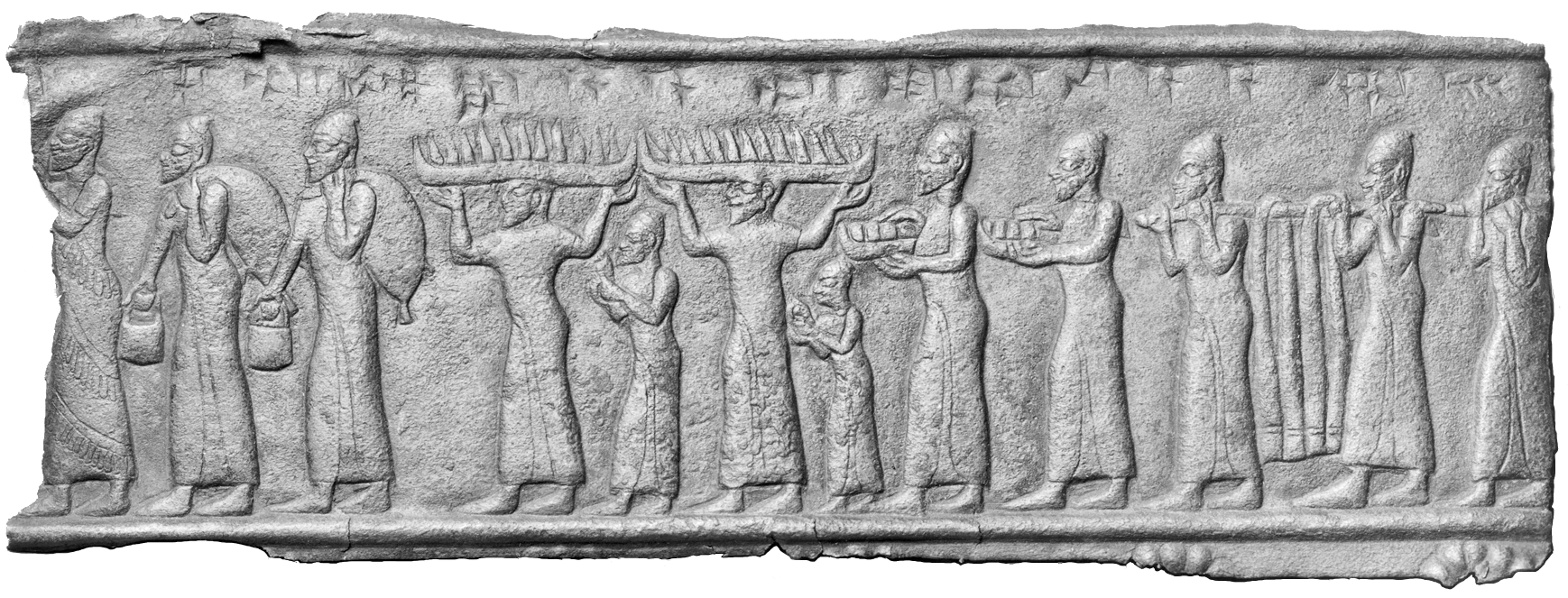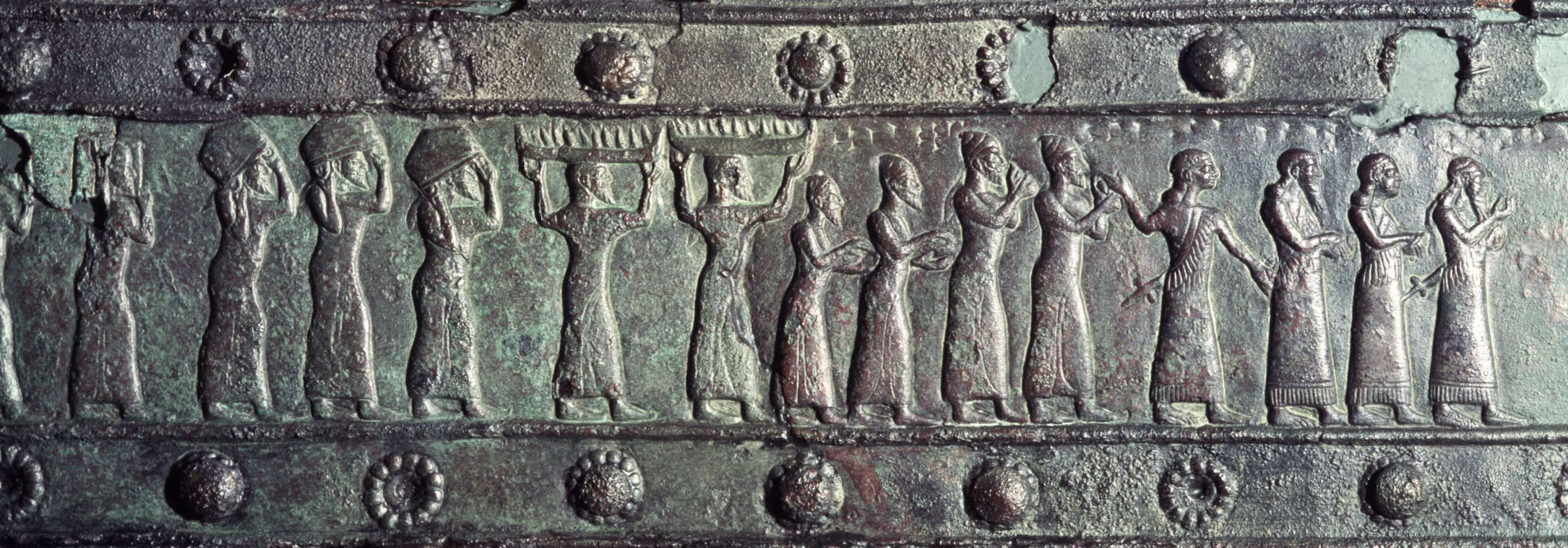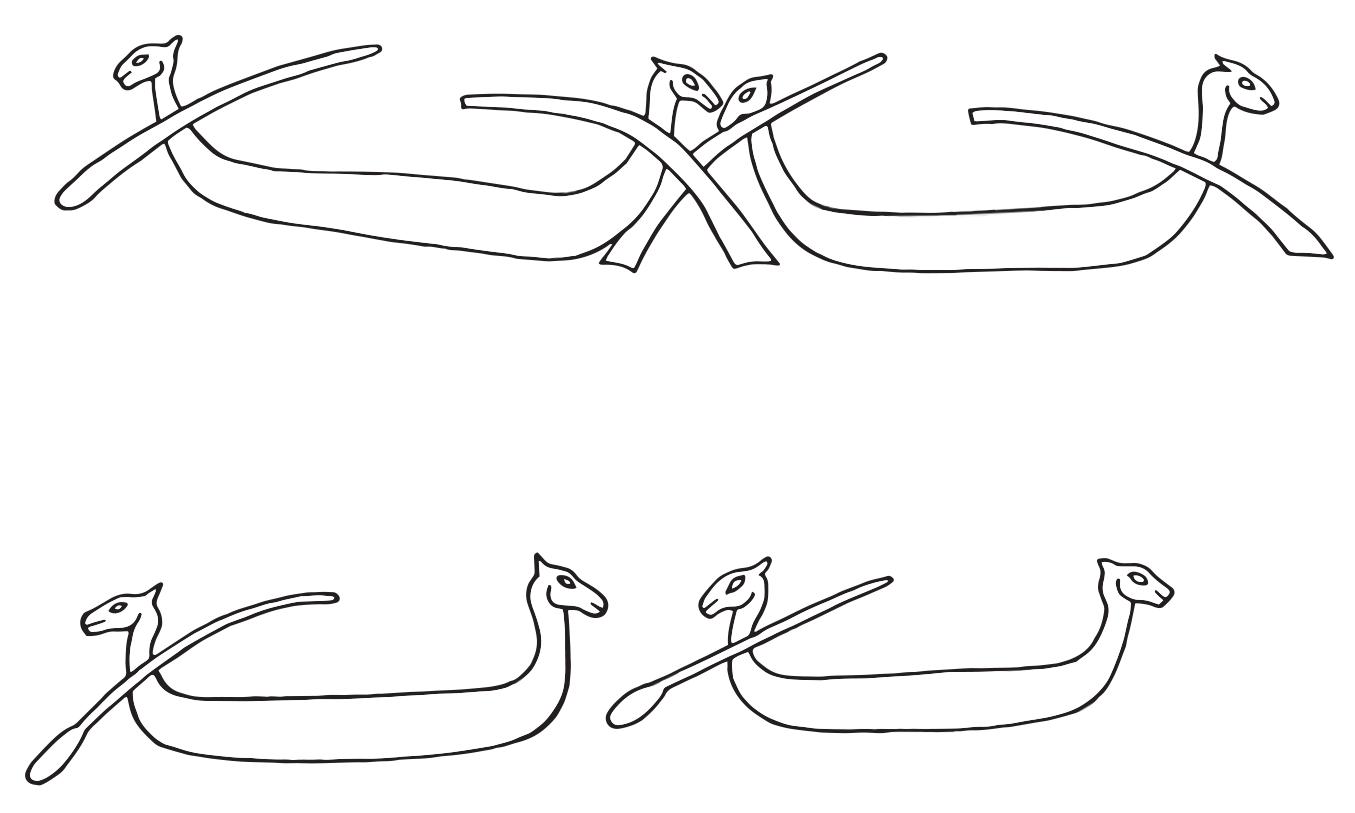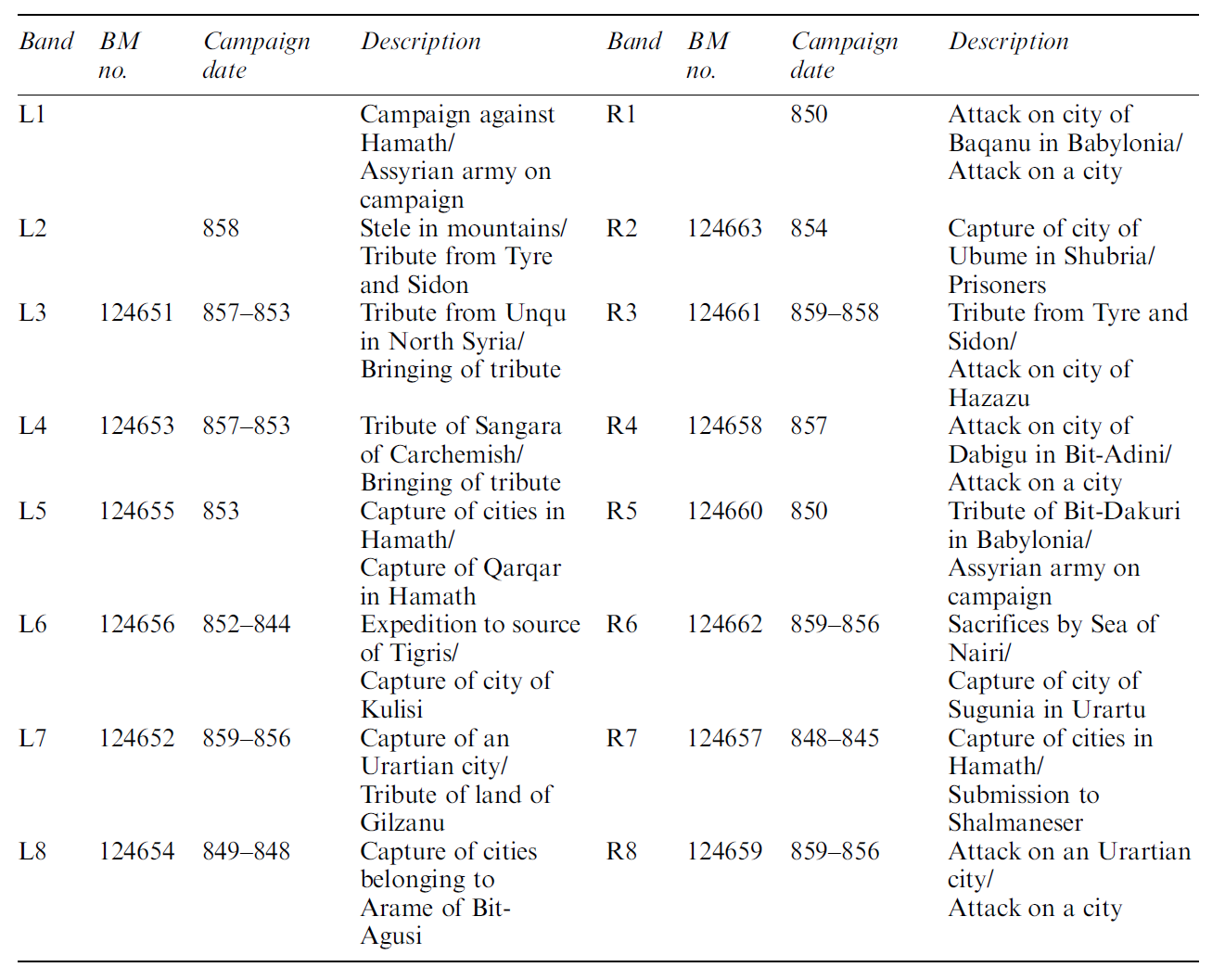Perfectly symmetrical boats with a flat hull and high vertical posts ending in a naturalistic horse head device. Each boat has two rowers. On Band R3, the oars are rendered as rectangles that slightly widen towards the oar blade. Three of them are shown slightly curving, while the left oar on the first boat is nearly straight. Band L2 has the oars rendered in greater detail. They are much thinner, with rounded oar blades. The pairs of ships on each band are identical except for the treatment of the oars and slight variations in the angle of the posts from one boat to another. On Band R3 they lean slightly outward, while on Band L2 the left boat has perfectly vertical posts, while the right boat has a left vertical post and a right post that is slightly inclined.
Ferrying of Phoenician tribute
L27
c. 848 B.C. (reign of Shalmaneser III)
Balawat, Northern Iraq
Doors: H: 27 cm; W: 180 cm; thickness: 0.1 cm Band L2: (frg. 1) H: 8.5 cm; L: 37 cm; (frg. 2) H: 10 cm; L: 28 cm
Fragmentary bands of bronze sheet with embossed and chased decoration
British Museum 124661 ; Louvre AO 14038 ; The Walters Art Museum 54.2335a
Band R3: Albenda 2021: 128, fig. 2; Aubet 2001: 37, 173-74, fig. 12; Billerbeck and Delitzsch 1908: pl. II, top; Birch and Pinches 1902: pls. H1-7; Curtis 2009: 428-31, figs. 2, 3; Curtis and Tallis 2015: 72, fig. 11; Friedman 2015: fig. 1a; Grayson 1996: A.O.102.66 (inscription); Gubel 1986: fig. 13; King 1915: pls. XIII-XVIII; Köster 1923: no. 10; Mauro 2019: 20, fig. 2.15; Sauvage 2007: 94, fig. 3; Tubb 2018: 128-129, No. 136
Band L2: Basch 1987: 305-306, no. 648; Billerbeck and Dellitzsch 1908: pl. IV, top right; Birch and Pinches 1902: pls. N1-2; Canby 1974: no. 18A; Curtis 2009: 428-29, fig. 1; Friedman 2015: fig. 1b; Grayson 1996: A.O.102.84 (inscription); Tubb 2014: 136, no. 44a,b
Detailed discussion of both bands: Schachner 2007: 38-39, 70-71, 225-227; Trakadas 1999: 39-48, figs. 13, 14
The site of Balawat is located 16 km north east of Nimrud. The mound is fairly small (250 x 150 m) but appears to have had a special strategic and religious significance. The two massive palace gates (H: 7.92 m; thickness: 7.5 cm) of Shalmaneser III were made of cedar. They were not hinged, but were instead fixed to huge pine pillars that revolved in stone sockets. Decorating and strengthening the outer face were eight long bronze bands spaced at regular intervals running across the flat part of the door and around the post, for a total of sixteen per door. These have embossed and chased decorations showing Assyrian campaigns and the receipt of tribute. Many of the scenes are accompanied by brief cuneiform epigraphs, with longer inscriptions recording the titles, genealogy and campaigns on Shalmaneser III on the bronze sheathings on the front edges of the door leaves (both top and bottom edges). Each band consists of a double register with embossed and engraved figurative scenes, framed above and below by borders within which are decorative rosettes that encased the dome-headed nails which were used to hold the bands in place. The bands do not reveal either a chronological or geographical pattern to their arrangement, although some vague symmetry is potentially discernible. The clear rationale behind their arrangement has thus not been elucidated. The scenes with Phoenicians ferrying tribute are located in the upper registers. The Assyrian annals do not record tribute specifically received from Tyre and Sidon until Shalmaneser III's 18th year (841 B.C.) and subsequently in his 21st-22nd year (838-837 B.C.), much later than the supposed erection of the gates. The bands thus probably represent Shalmaneer's campaign in the first year of his reign (858 B.C.) where he reached the Mediterranean sea. Although Tyre and Sidon are not explicitly mentioned, their contribution is highly probable. The Kurkh Monolith reads: "I overwhelmed [the cities on the shore of the] upper [sea] of the land Amurru, also called the western sea [...] I received tribute from the kings on the seashore. I marched about by right of victory in the extensive area of the seashore."
Band R 3: This is the third band from the top of the right gate, the band has an epigraph that reads: "I received tribute from the boats of the people of Tyre and Sidon." It depicts a fortress on the left perched on a rocky island rising out of the sea. The island is rendered with a scale pattern which is an Assyrian convention to denote a mountainous countryside. It is generally interpreted as denoting Tyre. The fortress does not extend to the island's edge; instead there is a rocky foreshore on which two figures stand. It has five towers connected by curtain walls and two doorways with rounded arches at the top, each framing a set of double doors. The crenellations atop the walls and towers have a triangular shape pointed at the top. Two figures, a man and a woman, are shown on the island's shore bringing dishes to two boats. It is possible that these represent a Phoenician king and queen. The boats have horse-headed devices at the bow and stern are being rowed towards the shore. They are laden with large square items stacked vertically (probably ingots) as well as trays with pointed objects and upturned cauldrons on top of them. Each boat is being rowed by two figures. The right boat is being pulled ashore with ropes by two men. Twenty three tributaries are shown moving towards the Assyrian king, carrying ingots, cauldrons, trays with pointed objects, and dishes. The figures have long hair and short beards. They wear slightly pointed caps that are sometimes folded over at the top and long beltless robes reaching down to the ankles. These have a split extending up to the waist and were therefore likely garments that were worn over another kind of long dress. The figures have shoes or boots which are occasionally shown with slightly curled toes. The delegation is led by four representatives of the Phoenician elite, distinguishable by the turbans on their heads. The tributaries are received by an Assyrian eunuch, who waves back to introduce them to the Assyrian king who is accompanied by courtiers and attendants, with his chariot and mount waiting behind him.
Band L2: This is the second band from the top of the left gate, preserved in two fragments. The band has an epigraph that reads: "I received tribute from the cities of the people of Tyre and Sidon: silver, tin, bronze, wool, lapis lazuli, (and) carnelian." The boats and dress of the tributaries are the same as on the previous band. The similarity of the scene suggests that there was most likely a fortress on an island beyond the right edge of the longer fragment, while the tributaries must have been received by the Assyrian king on the other side. One figure is giving a rectangular object to be loaded onto the right boat. The left boat has reached the other side and is being pulled ashore with a rope by two individuals. There are 18 tributaries preserved. The are some differences with the previous band in terms of the tribute depicted. The two boats are laden with rectangular ingots on top of which rest trays filled with pointed objects. The left boat also has two upturned cauldrons. The tributaries carry ingots, trays with pointed objects, animal skins, buckets, dishes, a bird, and textiles or skeins of wool suspended from poles.
Basch argues these are round merchant ships which the
Assyrian artist has diminished in size. There is no foundation for this
reading, as the depictions are very explicit and should be read
literally, as Aubet rightly does. There are a number of indications that
these are meant to depict small, lightweight craft that functioned for
local transport or fishing: 1) the boats safely reach the edge of the
water on either side; 2) cargo is simply loaded by hand; and 3) the
boats are hauled up ashore using ropes, requiring only two individuals.
All of these are good indicators that the scale of the boats compared to
the figures is accurate. Strabo's much later mention of Hellenistic
period boats called hippoi (named after the figure decorating their
prow) used by the sailors of Gadir for fishing in the region of Lixus
suggests that the small craft had a long history, including in the
Phoenician colonies in the west. He notes that occasionally these
fishing boats would stray too far and disappear at sea. It is notable
that in two other scenes of the Balawat bands where boats of the
Dakurians (southern Babylonia) and the Unquians (northern Syria) are
represented without any figureheads. These strengthen the association of
the horse headed prow with Phoenician craft.
In terms of the placement
of the bands, it should be noted that their position near the top of the
gates means they would not have been visible to visitors. Trakadas
argues that the Assyrian artists probably represented the local manner
of propulsion similar to that of contemporary native Assyrian quffas,
with two crewmen sitting opposite while rowing (Trakadas 1999: 48). The horse protomes
were then added according to him to highlight the Phoenician identity of
the boats.
Albenda, P. 2021. “A Sea or a River? The Sargon II maritime Scene,” N.A.B.U 2: 126-129.
Aubet, M.E. 2001. The Phoenicians and the West: Politics, Colonies, and Trade. M. Turton (trans.). Cambridge: Cambridge University Press.
Basch, L. 1987. Le musée imaginaire de la marine antique. Athens: Institut Hellénique pour la preservation de la tradition nautique.
Billerbeck, A. and F. Delitzsch. 1908. Die Palasttore Salmanassars II von Balawat. Beiträge zur Assyriologïe, 6. Leipzig: Hinrichs.
Birch, W. de G. and T. G. Pinches. 1902. The bronze Ornaments of the Palace Gates of Balawat (Shalmaneser II. B.C. 859-825). London: Society of Biblical Archaeology.
Canby, J. V. 1974. The Ancient Near East in the Walters Art Gallery. Baltimore: Trustees of the Walters Art Gallery.
Curtis, J. 2009. “Phoenicians on the Balawat Gates,” BAAL Hors-Série 6: 427-438.
Curtis, J. and N. Tallis. 2015. “More Thoughts on the Balawat Gates of Shalmaneser III: The Arrangement of the Bands.” Iraq 77: 59-74.
Friedman, Z. 2015. “The Phoenician Hippos Figurehead. Preserved Tradition and Types of Ship,” R. K. Pedersen (ed.) On Sea and Ocean: New Research in Phoenician Seafaring. Proceedings of the Symposion held in Marburg, June 23–25, 2011 at Archäologisches Seminar, Philipps-Universität Marburg. Marburg: Eigenverlag des Archäologischen Seminars der Philipps-Universität, pp. 19-34.
Grayson, A. K. 1996. Assyrian Rulers of the early First Millenium BC II (858-745 BC). The Royal Inscriptions of Mesopotamia, Assyrian Periods. Toronto: University of Toronto Press.
Gubel, E. 1986. Les Phéniciens et le monde méditerranéen. Bruxelles : Générale de banque.
King, L. W. 1915. Bronze Reliefs from the Gates of Shalmaneser King of Assyria, B.C. 860-825. London.
Köster, A. 1923. Das antike Seewesen. Berlin: Schoetz & Parr-hysius.
Mauro, C.M. 2019. Archaic and Classical Harbours of the Greek World: The Aegean and Eastern Ionian Contexts. Oxford: Archaeopress.
Sauvage, C. 2007. “Marine et navigation phéniciennes,” in E. Fontan and H. Le Meaux, H. (eds.) Les Phéniciens et la Méditerranée. De Tyr à Carthage. Paris: Institut du Monde Arabe, pp. 92-101.
Schachner, A. 2007. Bilder eines Weltreichs : Kunst- und Kulturgeschichtliche untersuchungen zu den Verzierungen eines Tores aus Balawat (Imgur-Enlil) aus der zeit von Salmanassar III, König von Assyrien. Turnhout: Brepols.
Trakadas, A. L. 1999. “Skills as Tribute: Phoenician Sailors and Shipwrights in the Service of Neo-Assyria.” MA dissertation, Texas A&M University, US.
Tubb, J. N. 2014. “Phoenicians and Aramaeans,” in J. Aruz, S.B. Graff and Y. Rakic (eds.) Assyria to Iberia at the Dawn of the Classical Age. New York: The Metropolitan Museum of Art, pp. 132-140.
Tubb, J.N. 2018. “The Levant and Assyria.” in G. Brereton (ed.) I am Ashurbanipal King of the World, King of Assyria. London: Trustees of the British Museum, pp. 118-137.



